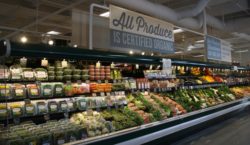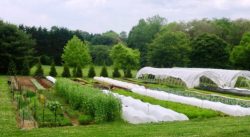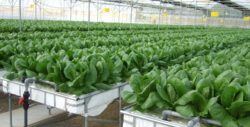Read Time: 5 Minutes Subscribe & Share
Produce Pitfalls
 Among the joys of writing Kitchen Detail posts are the rabbit holes I fall into on issues surrounding food (and you know how much I like rabbit). So when a farmer, whose produce I adore, brought up a topic that is dear to his heart, I was intrigued, as I had never thought about it. According to him, there’s a rumble in the jungle between organic farmers and hydroponic growers. As card-carrying conscientious consumers, we should be aware of the issues. I know you’ll be shocked to learn that the crux of the matter is — money.
Among the joys of writing Kitchen Detail posts are the rabbit holes I fall into on issues surrounding food (and you know how much I like rabbit). So when a farmer, whose produce I adore, brought up a topic that is dear to his heart, I was intrigued, as I had never thought about it. According to him, there’s a rumble in the jungle between organic farmers and hydroponic growers. As card-carrying conscientious consumers, we should be aware of the issues. I know you’ll be shocked to learn that the crux of the matter is — money.
The organic label provides a 40 billion dollar market. Hydroponic farming organizations would like to have a piece of that financial pie. Organic farming organizations are resisting extended use of the label “organic” because hydroponics and its cousins, aeroponics and aquaponics, are basically non-soil laboratory growing systems. Hydroponic proponents would like to add the “organic” nomenclature to their produce (one would like to be assured that the components and processes are organically certified). Arguments are muddied because US regulations are unlike their EU counterparts, which allow only produce and animals that are raised in organically certified soil to use the term. There is mounting resistance (and legal confrontations) from certified organic farming organizations representing those who till the soil, so to speak. So to understand a bit more, let’s go back to the beginning.
Stewards of The Earth
 First of all, organic farming, which has its roots in 19th century agricultural research in Germany and England, was a term coined by a British baron in 1940. Lord Northbourne wrote a book Look To The Land which posited farming as an organism in which the soil was nurtured in an ecologically sound way to produce food. The backdrop for his book was the chemical intrusion of man-made nitrogen fertilizers that had been a by-product of the nitrogen explosives development in the first World War. As the wonders of chemical aids in producing bigger crops and fatter animals in less time took hold, a core of resistance developed (particularly in the US) through groups and publications such as the Rodale Press and of course the seminal work Silent Spring by the scientist Rachel Carson. (As a horrifying side note, I remember welcoming the DDT spraying planes in Rehoboth, Delaware as children. We would run under the whoosh of the DDT when the planes flew over. Yikes.) An interesting sub-group of the organic farming movement is “biodynamic.” Some growers use the terms organic and biodynamic when describing how they farm. Many biodynamic concepts were developed by Rudolf Steiner of Waldorf School fame in the early 20th century. The concept veers a bit off from what we perceive as organic farming in that it theorizes a mystical side to the endeavor, positing that a farm is in itself both a physical and a spiritual organism. All its parts are treated as a whole being. You can see the unfolding of this process in the film “The Biggest Little Farm”. In biodynamic’s most extreme forms, astrology and probably some other “pseudo sciences” are used to dictate planting, and perceived traditional magic formulas enhance farming practices. The most famous example from Wikipedia is “burying ground quartz into the horn of a cow,” which is said to harvest “cosmic forces in the soil.” But in the end, organic farming comes down to growers and consumers treating the earth and its products as an organism that is to be regenerated and preserved in a natural state.
First of all, organic farming, which has its roots in 19th century agricultural research in Germany and England, was a term coined by a British baron in 1940. Lord Northbourne wrote a book Look To The Land which posited farming as an organism in which the soil was nurtured in an ecologically sound way to produce food. The backdrop for his book was the chemical intrusion of man-made nitrogen fertilizers that had been a by-product of the nitrogen explosives development in the first World War. As the wonders of chemical aids in producing bigger crops and fatter animals in less time took hold, a core of resistance developed (particularly in the US) through groups and publications such as the Rodale Press and of course the seminal work Silent Spring by the scientist Rachel Carson. (As a horrifying side note, I remember welcoming the DDT spraying planes in Rehoboth, Delaware as children. We would run under the whoosh of the DDT when the planes flew over. Yikes.) An interesting sub-group of the organic farming movement is “biodynamic.” Some growers use the terms organic and biodynamic when describing how they farm. Many biodynamic concepts were developed by Rudolf Steiner of Waldorf School fame in the early 20th century. The concept veers a bit off from what we perceive as organic farming in that it theorizes a mystical side to the endeavor, positing that a farm is in itself both a physical and a spiritual organism. All its parts are treated as a whole being. You can see the unfolding of this process in the film “The Biggest Little Farm”. In biodynamic’s most extreme forms, astrology and probably some other “pseudo sciences” are used to dictate planting, and perceived traditional magic formulas enhance farming practices. The most famous example from Wikipedia is “burying ground quartz into the horn of a cow,” which is said to harvest “cosmic forces in the soil.” But in the end, organic farming comes down to growers and consumers treating the earth and its products as an organism that is to be regenerated and preserved in a natural state.
Not Soylent Green
Contrary to the nightmare sci fi film from 1973, hydroponics has been around a long time. Hydroponic principles were used in the Hanging  Gardens of Babylon and later with floating gardens in China and in the Aztec culture. Modern hydroponics is based on raising certain crops in a growing medium with added nutrient food in a recirculated water bath. The growing medium (i.e perlite, gravel, packing composites) holds the root system in place while the plant receives light either naturally or mechanically. Aeroponics is basically a “tower” of plants fed by a nutrient-enriched water mist. Aquaponics is raising a crop that is attached to a fish tank (usually tilapia) so that the waste excreted by the fish feeds the plants. The advantages of these food crop systems are obvious. They can be constructed anywhere you have access to power – city centers, even solar-powered commercial farms in dry areas. A sterile environment eliminates the need for using pesticides and encourages year-round production. Less space and water is used. There is no required regeneration of the soil through mulching and cover crops. The fly in the ointment is multi-headed, though. These artificially manufactured growing systems are not inexpensive and require constant technical expertise. They are obviously subject to power outages and can be destroyed by waterborne microorganisms that can invade despite a sterile atmosphere. It is interesting to note that the earth itself offers plants a buffer to fight off pests that these systems do not.
Gardens of Babylon and later with floating gardens in China and in the Aztec culture. Modern hydroponics is based on raising certain crops in a growing medium with added nutrient food in a recirculated water bath. The growing medium (i.e perlite, gravel, packing composites) holds the root system in place while the plant receives light either naturally or mechanically. Aeroponics is basically a “tower” of plants fed by a nutrient-enriched water mist. Aquaponics is raising a crop that is attached to a fish tank (usually tilapia) so that the waste excreted by the fish feeds the plants. The advantages of these food crop systems are obvious. They can be constructed anywhere you have access to power – city centers, even solar-powered commercial farms in dry areas. A sterile environment eliminates the need for using pesticides and encourages year-round production. Less space and water is used. There is no required regeneration of the soil through mulching and cover crops. The fly in the ointment is multi-headed, though. These artificially manufactured growing systems are not inexpensive and require constant technical expertise. They are obviously subject to power outages and can be destroyed by waterborne microorganisms that can invade despite a sterile atmosphere. It is interesting to note that the earth itself offers plants a buffer to fight off pests that these systems do not.
Field Notes From A Consumer on Organic & Hydroponic Growing
 I buy certified organic groceries, and stuff that is just marked sustainably produced or raised along with hydroponically raised. But I also had a bit of an unexpected “epiphany” in Sicily when I ate “white breads.” I could actually taste the differences in the flours. And I must say that having bought (and continuing to do so) hydroponic lettuce along with field-grown lettuce, there is a lack of flavor in the water-grown versions versus the field-grown ones. Ditto tomatoes and berries. The hydroponically raised watercress that I have bought does not taste as good as the stream-grown watercress. There is a reason to focus on seasonal and field-grown in terms of taste Rather than just looking at the organic dollar signs, my opinion is that hydroponic growers and their subset aero and aqua techno-farmers should set up their own certification process for “clean” ponic agriculture. The FDA should strengthen the requirements for organic certification as they do in the EU.
I buy certified organic groceries, and stuff that is just marked sustainably produced or raised along with hydroponically raised. But I also had a bit of an unexpected “epiphany” in Sicily when I ate “white breads.” I could actually taste the differences in the flours. And I must say that having bought (and continuing to do so) hydroponic lettuce along with field-grown lettuce, there is a lack of flavor in the water-grown versions versus the field-grown ones. Ditto tomatoes and berries. The hydroponically raised watercress that I have bought does not taste as good as the stream-grown watercress. There is a reason to focus on seasonal and field-grown in terms of taste Rather than just looking at the organic dollar signs, my opinion is that hydroponic growers and their subset aero and aqua techno-farmers should set up their own certification process for “clean” ponic agriculture. The FDA should strengthen the requirements for organic certification as they do in the EU.
I certainly think there has to be room for both earth- and water-produced crops. But I have come to value what “organic” means in terms of caring for the earth, both in its immediate and larger philosophical sense, in a way that caring for plastic tubing and water buckets does not. Organic now has my understanding and increased affection for being such a good steward of the planet.

Kitchen Detail shares under the radar recipes, explores the art of cooking, the stories behind food, and the tools that bring it all together, while uncovering the social, political, and environmental truths that shape our culinary world.




Thank you, Nancy, for an insightful post. You have given me greater understanding of my recent disappointment with hydroponically raised basil. There is clearly a place for hydroponics, but good to differentiate it from organic farming.
I just bought a hydroponically raised basil and an organic one, and you are right, there is a distinct difference in flavor.
Nancy
Spot on Nancy. Thank you for this thoughtful and informative piece.
Thank you so much.. i was completely unaware of the difference between the farming and growing and labelling of produce! Not surprising there’s still a lot of folks unaware of differences and flavors and nutritional content?